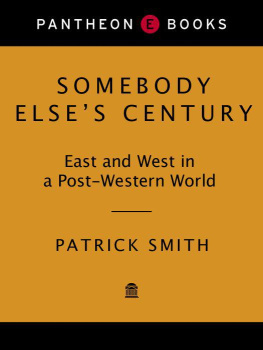

This edition first published 2013
2013 John Wiley & Sons, Inc
Wiley-Blackwell is an imprint of John Wiley & Sons, formed by the merger of Wileys global Scientific, Technical and Medical business with Blackwell Publishing.
Registered Office
John Wiley & Sons, Ltd, The Atrium, Southern Gate, Chichester, West Sussex, PO19 8SQ, UK
Editorial Offices
350 Main Street, Malden, MA 02148-5020, USA
9600 Garsington Road, Oxford, OX4 2DQ, UK
The Atrium, Southern Gate, Chichester, West Sussex, PO19 8SQ, UK
For details of our global editorial offices, for customer services, and for information about how to apply for permission to reuse the copyright material in this book please see our website at www.wiley.com/wiley-blackwell .
The right of Laura Nader to be identified as the author of this work has been asserted in accordance with the UK Copyright, Designs and Patents Act 1988.
All rights reserved. No part of this publication may be reproduced, stored in a retrieval system, or transmitted, in any form or by any means, electronic, mechanical, photocopying, recording or otherwise, except as permitted by the UK Copyright, Designs and Patents Act 1988, without the prior permission of the publisher.
Wiley also publishes its books in a variety of electronic formats. Some content that appears in print may not be available in electronic books.
Designations used by companies to distinguish their products are often claimed as trademarks. All brand names and product names used in this book are trade names, service marks, trademarks or registered trademarks of their respective owners. The publisher is not associated with any product or vendor mentioned in this book. This publication is designed to provide accurate and authoritative information in regard to the subject matter covered. It is sold on the understanding that the publisher is not engaged in rendering professional services. If professional advice or other expert assistance is required, the services of a competent professional should be sought.
Library of Congress Cataloging-in-Publication Data
Nader, Laura, author.
Culture and dignity : dialogues between the Middle East and the West / Laura Nader.
pages cm
Includes index.
ISBN 978-1-118-31900-0 (cloth) 978-1-118-31901-7 (pbk.)
1. Civilization, Arab. 2. EthnologyArab countries. 3. ArabsEthnic identity.
4. East and West. 5. Western countriesRelationsArab countries. 6. Arab countries
RelationsWestern countries. I. Title.
DS36.8.N324 2013
303.4825601821dc23
2012015890
A catalogue record for this book is available from the British Library.
Cover image: Detail of mosaic, Umayyad mosque, Damascus, Syria, AD 705-715. DEA / C. SAPPA / Getty Images.
Cover design by Cyan Design.
In recognition of Donald Cole and Soraya Altorki,
ethnographers of the Arab East par excellence
In memory of Anthony Shadid,
journalist with an ethnographers eye
Acknowledgments
It is not possible to acknowledge all the colleagues, students, family members and others who over the years have enriched my understanding of a world without boundaries, the context for my work. First and foremost were the invitations from the American University of Cairo to deliver lectures that form the core of this book. Soraya Altorki, Donald Cole, Nicholas Hopkins, and Nawal Hassan were warm and generous hosts. The people of Egypt whom I met outside of the university community the Minister of Energy, as well as Mrs. Mubarak who had studied anthropology at the American University, journalist Gamal Nkruma and others enriched and broadened my understandings of political happenings in modern-day Egypt.
Support for preparing the manuscript came from the Middle East Center at UC Berkeley and the Committee on Research. The Rothko Chapel hosted my talk on human rights, which was later welcomed for publication in Brazil. My colleague Rik Pinxton of Cultural Dynamics saw my article Orientalism, Occidentalism, and the Concept of Women (reissued as Chapter 4 of this book) through to publication in Belgium, a piece that was then considered controversial in the United States. Mohammed Hamdouni Alami provided the photograph of the Great Umayyad Mosque in Damascus, taken in 2007, for the cover of this book.
With regard to Chapter 4, I have also to thank Andre Sursock, Seteney Shami, JoAnn Martin, and Saddeka Arebi, who were of enormous help in searching out and arguing with me about the comparative materials. The need to explore the idea of occidentalism first crystallized in a conversation with Professor Ashraf Ghani of Johns Hopkins University. Comments from Drs Mondher Kilani, Soheir Morsy, and Guita Debert were most helpful, as were the audiences at UC Davis, UC Berkeley, the University of Auckland, Harvard University, Claremont Colleges and other academic institutions where I presented those ideas.
Over the years at Berkeley I was primary thesis advisor to more than a dozen students working in the Middle East: Golamareza Fazel (Iran), Donald Cole, Soraya Altorki, and Saddeka Arebi (Saudi Arabia), John Rothenberger, Cathy Witty, and Osama Doumani (Lebanon), Seteney Shami (Jordan). June Starr and Ayfer Bartu (Turkey), Andre Sursock (France), Rochelle Shain (Israel), Nell Gabian (Syria), Monica Eppinger (Ukraine) I learned from every one of them.
My colleagues Elizabeth Colson, Roberto Gonzalez, and Salwa Mikdadi, as well as former students Saddeka Arebi, Seteney Shami, Ayfer Bartu, Andre Sursock, Maysunn Succarie, Alberto Sanchez, Roberto Gonzalez, Monica Eppinger, Chris Hebdon, and others read, researched, and provided critical comments on this book. Claire Nader, Ralph Nader, and Tarek Milleron were the toughest of critics, forcing simplicity of style and intolerant of facile generalizations. Suzanne Calpestri and David MacFarland of the Mary and George Foster Library were ready to help in myriad ways. Gratitude is due to Shirley Taylor, Tarek Milleron, and Stephen Curtis for editorial help, to Kathleen Van Sickle for patience in typing and retyping various versions, to Chris Hebdon for hanging in to the end, to Rosalie Robertson my editor, always supportive and cheerful, and to the three anonymous readers for their encouraging comments.
Preface
Cultural anthropologists set their discipline apart a century and a half ago by formalizing a historical tradition of extensive observation carried out among peoples foreign to the observer either by distinct customs and practices or by more subtle differences. Through painstaking examination of another culture might come an ability to grasp and understand its honor and dignity that is, to understand how shared culture may serve a people and how that culture may continue to do so, or where it may begin to break down thereby exposing its members to indignities small and large. But cultures are never as simple as bounded units changing in isolation. The anthropologist must also trace elements that fire across cultural groups and across geographic areas. In the same vein, the observer runs the risk of using imaginary yardsticks, often idealized from his or her own cultural group, to make comparisons unmoored from the real and very messy world. My work related to the Arab East through field observations, decades of teaching, lecturing, and writing covers half a century. During this time, I have observed a level of bounded thinking, sometimes referred to as ethnocentrism, that has only grown more rigid as the United States and Europe have become more embroiled in the Arab World and tried to define the East relative to their own societies. This book is my attempt to provide an anthropological sorting out, a sense of what the quality of our observations means for our own culture and dignity, and how thorough an exploration of culture might have to be in order to reach an understanding of another human dignity in relation to ours.
Next page










